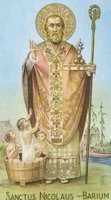The Real Saint Nick
While many Christians give presents sometime during early winter, many avoid gift-giving on Christmas. Some wait until Epiphany on 6 January, since this day celebrates the Wise Men arriving in Bethlehem and giving their gifts of gold, frankincense, and myrrh to the Christ Child.
In much of Europe, children will receive presents this Thursday (6 December), which is Saint Nicholas Day. Stories about this Third Century pastor’s generosity gradually led to tales of his ongoing bringing of presents. Yet the Nicholas of history bears scant resemblance to the “jolly old elf” of Clement Moore’s poem or the chunky, red-clad image developed by Thomas Nast and expanded by Coca-Cola.
Actually, we know very little about the original St. Nick. A study of his remains indicates a man barely 5 feet tall who at one time suffered a broken nose. Whether broken as an adult or a child, we don’t know — although he seems to have had a rather combative nature, particularly when faced with an unrepentant heretic. Because Arius denied the full divinity of Jesus, Nicholas reportedly slapped him during a meeting of the Council of Nicaea.
The other bishops didn’t take this lightly and Nicholas’s violence dismayed even the most orthodox among them. Their strong rebuke included a threat to strip him of his bishopric but Nicholas quickly repented his action and remained in office.
 The bringer of gifts obviously grew out of different stories. He seemingly came from a wealthy family. Desiring to serve God in physical poverty, he gave away his inherited fortune and gained renown for his generosity, especially toward the truly poor and needy. The stories say that he gave his contributions in secret whenever possible.
The bringer of gifts obviously grew out of different stories. He seemingly came from a wealthy family. Desiring to serve God in physical poverty, he gave away his inherited fortune and gained renown for his generosity, especially toward the truly poor and needy. The stories say that he gave his contributions in secret whenever possible.An apocryphal story tells of three sisters whose father wasted the family fortune. If a girl had no dowry, she had no way to marry into a respectable family. Normally, only slavery or prostitution would be such a woman’s means of support. When Nicholas about them, he sneaked up to the house and tossed sufficient dowry money through the sleeping family’s windows so that the girls could each wait for a proper marriage. Some versions have him wrapping coins (and jewels) in stockings — beginning a tradition of gifts in stockings.
 The three bags of gold were later stylized into three golden balls, which passed into usage as the sign of pawnbrokers. Perhaps the connection is that those in dire financial straits often turn to such people in order to gain ready cash to tide them through their troubles. Because of this, when patron saints became popular, he became favored by pawnbrokers. Additionally, many sailors looked to him for help.
The three bags of gold were later stylized into three golden balls, which passed into usage as the sign of pawnbrokers. Perhaps the connection is that those in dire financial straits often turn to such people in order to gain ready cash to tide them through their troubles. Because of this, when patron saints became popular, he became favored by pawnbrokers. Additionally, many sailors looked to him for help.His patronage for children stemmed from another apocryphal story, one much less likely than that of the three sisters. In it, he raised three boys from the dead after they’d been murdered by an evil butcher and placed in a brine barrel to be cured and sold as ham. Perhaps the salty brine also led to the connection with sailors.
So if you’re tired of the commercialization of Christmas but still want to keep Santa in some way, or if you just want your presents three weeks sooner than everyone else, maybe you should look into celebrating St. Nicholas Day. And if you do pause to remember the saint, here’s a hymn verse I wrote for the commemoration:
With joy Your Church remembers
Saint Nicholas, the blest,
Who gave up earthly treasures
And Jesus’ name confessed.
The poor and weak he welcomed,
The heretic he scorned;
Through faith and life and preaching,
Christ’s Gospel he adorned.
Added note: For a bit more, including Lection and Collect, check this post from Aardvark Alley.
Send email to Ask the Pastor.
Walter Snyder is a Lutheran pastor, conference speaker, author of the book What Do Lutherans Believe, and writer of numerous published devotions, prayers, and sermons.
Article first appeared in The Concordian of 5 December AD 2012.


0 Comments:
Post a Comment
<< Home